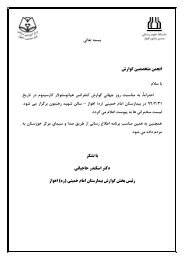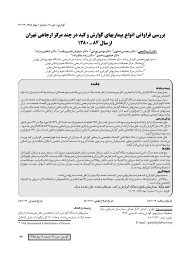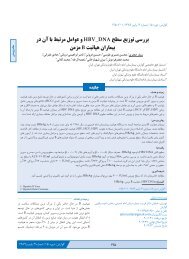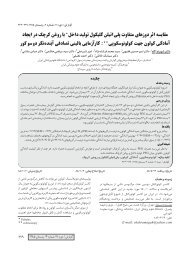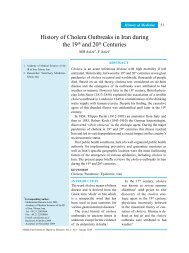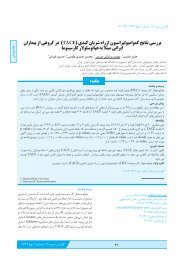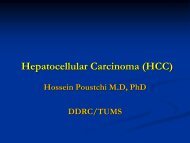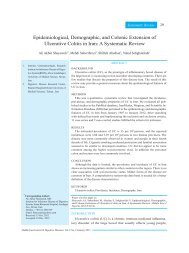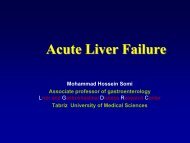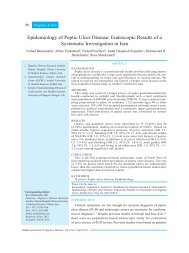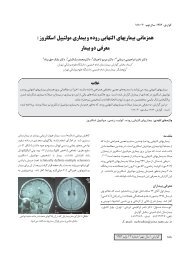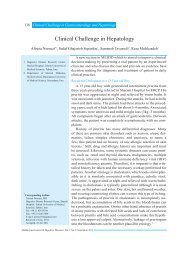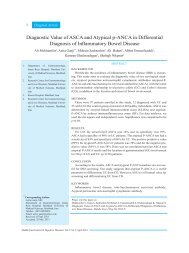ACUTE CALCULOUS CHOLE CYSTITIS ACUTE ... - IAGH
ACUTE CALCULOUS CHOLE CYSTITIS ACUTE ... - IAGH
ACUTE CALCULOUS CHOLE CYSTITIS ACUTE ... - IAGH
You also want an ePaper? Increase the reach of your titles
YUMPU automatically turns print PDFs into web optimized ePapers that Google loves.
REFERENCES<br />
STRAS BERG SM. <strong>ACUTE</strong> <strong>CALCULOUS</strong> <strong>CHOLE</strong><strong>CYSTITIS</strong><br />
N ENGL J MED 2008; 358:2804-11<br />
HUFFMAN JL, SCHENKER S. <strong>ACUTE</strong> A<strong>CALCULOUS</strong> <strong>CHOLE</strong><strong>CYSTITIS</strong>:<br />
A REVIEW. CLIN GASTROENTEROL HEPATOL 2010; 8:15-22.
• A complication of Cholelithiasis<br />
20 millions in USA/year<br />
• Most Gallstones Asymptomatic<br />
• Biliary colic develops 1% to 4%<br />
• Acute cholecystitis in 20% of these symptomatic patients<br />
‣ 60% women<br />
‣ Older<br />
• With/without previous attacks<br />
‣ More frequent in men relative to its incidence and more severe<br />
‣ DM<br />
• 90% of acute cholecystitis is associated with gallstones
Figure 1. Ultrasonographic images of three Gallbladders.<br />
A normal, sonolucent gallbladder (panel A) is characterized<br />
by a thin wall and an absence of acoustic shadows. In a<br />
patient with symptomatic gallstones (panel B), the<br />
gallblader contains small echogenic objects with posterior<br />
acoustic ghadows that are typical of gallstones (arrow),<br />
with a normal wall thickness. In a patient with acute<br />
calculous cholecystitis (panel c), thickening is visible in the<br />
gallbladder wall (arrow), along with a lare gallstone<br />
(arrowhead)
Figure 2. Hepatobiliary Scintigraphy.<br />
Figure<br />
InPanel<br />
2. Hepatobiliary<br />
A, a normal<br />
Scintigraphy.<br />
liver is visible 10 minutes after the intravenous injection of a technetium-labeled analogue of iminodiacetic acid.<br />
In InPanel B, A, at a 55 normal minutes liver after is visible tracer 10 injection, minutes filling after of the the intravenous bile duct (arrow) injection and of gallbladder a technetium-labeled (arrowhead) analogue can be seen. of iminodiacetic In Panel C, acid. at<br />
1 hour In Panel after B, tracer at 55 injection minutes in after a patient tracer with injection, acute filling cholecystitis of the bile and duct obstruction (arrow) and of the gallbladder cystic duct, (arrowhead) there is filling can of be the seen. bile In duct Panel C, at<br />
(arrow) 1 hour but after no filling tracer of injection the gallbladder. in a patient with acute cholecystitis and obstruction of the cystic duct, there is filling of the bile duct<br />
(arrow) but no filling of the gallbladder.
• Local symptoms and signs<br />
Murphy's sign<br />
Pain or tenderness in RUQ<br />
Mass in RUQ<br />
• Systemic signs<br />
Fever<br />
Leucocytosis<br />
Elevated CRP<br />
• Imaging findings<br />
A confirmatory finding on US or HB scintography<br />
Presence of one local signs or symptoms<br />
One systemic sign, and<br />
A confirmatory finding on an imaging test
acute cholecystitis not meeting criteria for a more severe grade<br />
Mild gallbladder inflammation, no organ dysfunction<br />
VA<br />
presence of one or more of following:<br />
WBC>18000<br />
Palpable, tender mass in RUQ<br />
Duration > 72h<br />
Marked local in tlammarion: biliary peritonitis, pericholecystic abscess, hepatic<br />
abscess, gangrenous cholecystitis, emphysematous cholecystitis<br />
VB<br />
presence of one or more of following:<br />
• CVS dysfunction ( BP requiring dopamine at ≥ 5 microgr/kg/min or any dose of Dobutamine)<br />
• CNS dysfunction (level of consciousness)<br />
• Respiratory dysfunction (ratio of pO 2 of arterial blood to the fraction of inspired oxygen 2mg/dL) Hepatic dysfunction (PT INR >1.5)<br />
• Hematologic dysfunction (platelet
Laparascopic VS open<br />
Early VS delayed<br />
From 24h to 7 days after initial attack<br />
2-3 months after afte initial attack<br />
Percutaneous<br />
Operative
Fasting, obstruction, post surgical ileus, TPN<br />
Inspissated bile toxic to epithelium
Clinical findings<br />
Setting (inpatient, out patient)<br />
Fever, abdominal pain<br />
Leucocytosis, abnormal LFT<br />
Radiology<br />
US<br />
CT<br />
HIDA SCAN<br />
Surgery<br />
Aspiration of GB/ drainage<br />
Laparatomy
Figure 1. (A and B) Longitudinal and horizontal sonogram of a 64-year-old man with positive<br />
Murphy sign, showing hydrops. (C) CT scan 6 hours later showing thickened GB wall<br />
(white arrow), hydrops, and pericholecystic inflammation (asterisk). Figure courtesy<br />
of Dr Shaile Choudhary, MD (Department of Radiology, University of Texas Health<br />
Science at San Antonio, San Antonio, TX).



